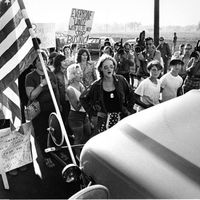Teacher Lesson Plans
Objective: To familiarize students with Judge Keith's decisions that have impacted the education system in Michigan. Students will be able to examine primary sources related to the de-segregation of schools in Pontiac, MI, while drawing connections to a larger context of fighting for civil rights and racial equality in America.
De-segregation of schools in Pontiac, MI
Early in 1969, Elbert L. Hatchett, then president of the Oakland County NAACP, filed suit in Federal Court complaining that Pontiac schools were deliberately segregated. Statistics showed that schools were either 90 percent white or 90 percent black.
Federal Judge Damon J. Keith, the only black jurist on Detroit’s district bench, received the case assignment. While the case lost momentum in the courts, race relations in the city worsened. Resentment by blacks over the location of a proposed new $19 million high school in an all-white neighborhood caused tensions to escalate. Confrontations ranged from a “lock-in” of the school board by militants, to sit-ins by blacks at the city’s two high schools. The school board finally agreed to a compromise by putting the new school near downtown.
The school board insisted that they had created several policies to support integration. Judge Keith famously replied, "Pronouncement of good intentions with nothing more amounts to monumental hypocrisy.” In February 1970, he ordered the local school district to begin busing students to racially balanced schools by that fall.
Many parents were outraged that their children would be moved to different schools or children from other neighborhoods would be coming into their own communities.
Busing for school integration in Pontiac, MI (pictures and discussion)
Educator: What do you think is happening in these pictures? Allow students to respond, and take notes while students observe. What do they see? What words can they read? Make sure to differentiate between things they can observe and things they suspect. Click on each picture to read the description to students afterwards.
Discuss how these images of the past connect to current events. Do students notice any similarities to new stories today?
These images may have a strong impact on students. Make sure to create safe space for students' reactions.
Further Discussion: Discuss with students their knowledge of segregation in American schools. Consider pairing this discussion with a short reading assignment, such as an oral history from students in integrating schools. Questions that could further class discussion:
- Why do you think integration in schools is so important?
- Why do you think so many parents opposed integrating schools during that time (The 1970's)?
- What do you think of Judge Damon Keith’s ruling for the city of Pontiac? Was it a good idea? Why or Why not? What other solutions could you see?
Objective: The objective of this lesson is to discuss with students the importance of one’s own role in the greater good of society. In this lesson, Judge Keith’s contributions to education through the Damon Keith Center for Civil Rights at Wayne State University and a former elementary school with his namesake will be discussed. Students will have a chance to also think about their own lives and what impact they want to leave on their community, neighborhood, and the world.
Educators: Ask students: do they know who or what their school is named after? If the school is not named for a person, consider a local park or municipal building. Example: Lewis Cass Technical High School (Detroit, MI). Who was Lewis Cass? Why do you think a school was named after him?
Next: Show students the flyer from Judge Damon Keith’s School found in the document gallery.
Discussion: Why do you think Judge Keith was chosen as a name for the school? What other reasons might a school be named after a person?
Activity and Discussion: If you were to put all of your accomplishments in a time capsule for someone else to read and/or see, what would you want to put in there? Alternatively: Imagine, 70 years from now you are asked to write down all of your accomplishments to share with people after you are gone. What do you hope to put in there? What about if you had to do it today? This may be appropriate as a homework assignment or hands-on project.
Educators: Discuss the Judge Damon Keith Civil Rights Center at WSU and his intentions for it. Information is listed below.
Located in Detroit and embedded within Wayne State University's Law School, the Damon J. Keith Center for Civil Rights addresses the civil rights needs of southeast Michigan and beyond. The Keith Center's mission is to promote the educational, economic and political power of underrepresented communities in urban settings.
Our communities need institutions that call attention to today's civil rights challenges and that nurture social conscience. The Keith Center strives to be one such institution: a hub for civil rights teaching, research and action, and a place that fuels the next generation of civil rights leaders.
At the Keith Center, stakeholders gather to analyze policy, law students teach a civil rights curriculum to high school students, and leaders dive into the equity issues of the day, such as tax foreclosures, water shutoffs and police-community relations. The Center welcomes the public for lectures by civil rights icons, supports community-based organizations, and publishes scholarship about how the law and social justice impact one another.
Homework: Bring one item that represents you as a person. Go around the class to share your item. What do you want people to know about how it represents you?
Objective: The goal of this is to have students think about whom they are and who they want to be in the future both professionally and personally.
This lesson plan was created to give students a closer look at the importance of primary sources in analyzing history and forming one's own opinion based on factual information. It also highlights the significance of contributing to your own legacy, for the benefit of future generations as seen through the life and works of Judge Damn Keith.



